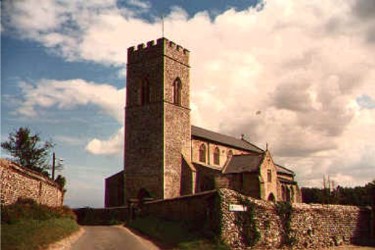
Above, the All Saints Church in Wighton, Norfolk
Here's the kilt maker's theory on why Wightons came to Scotland from Wighton in Norfolk. In the 18th century, after the Jacobite rebellion, there is evidence that some families from Norfolk were assigned to Meigle by the church to oversee the strict new legislation imposed on the defeated Scots after the battle of Culloden. The Norfolk village of Wighton was an ecclesiastical centre. This, coupled with the fact that Meigle was an ecclesiastical centre and could afford protection for an Englishman living in hostile territory, drew me to the conclusion that at some point your family probably originated from there.
Here's what I found in my research.
Meigle did have an ecclesiastical history through its association with the Bishops of Dunkeld. Dunkeld Cathedral had been holy ground in Scotland since about 730 when the relics of St. Columba were moved there from Iona on the west coast. However, the Bishops of Dunkeld were Roman Catholic. Their cathedral in Dunkeld was destroyed in 1560 by order of Reformation leaders and their lands confiscated. So low did the revenues of Dunkeld, amongst others, become that the King had to make a gift of a hundred pounds to the incumbent in 1689. (Source: Dunkeld Cathedral) While some Bishops of Dunkeld are recorded as living in Meigle in 1607, this association was in order to augment the stipend at Dunkeld. All of this suggests that if any Bishops of Dunkeld were still living in Meigle after the Battle of Culloden, they would have had no influence in a country that had long ago rejected Catholicism. If the English brought Wightons into Meigle, it was not to maintain order as part of a virtually extinct Roman Catholic institution.
From what I could discover, the village of Wighton in Norfolk was always a farming community. I found no reference to it being an ecclesiastical community. However, there was a Creake Abbey about 7 miles to its west. It was founded by the Augustinians as a priory and was made into an abbey in 1231. (Interestingly, one of the abbots was John de Wighton who served in that capacity from 1393 to 1412.) The Abbey ceased to function after an epidemic wiped out the community in the last part of the 15th century. Creake was never a wealthy abbey and there is no indication that it might have had anything to do with catholic bishops in Scotland.
England did have a history of maintaining control over Scotland's people with its army. England used garrisons of soldiers to maintain order after Cromwell's conquest of Scotland (1650-1660) and there is some evidence that some soldiers married and remained in Dundee. (The author of Dundee's Statistical Accounts noted that 66 English soldiers were married in Dundee from 1652 to 1658. Wightons were not part of that English garrison. We had no marriages recorded during that six year period and the Wighton family history actually preceded Monk's assault on Dundee.) Meigle was too small a village for there to be a need for any English soldiers after the Battle of Culloden.
England did use forced emigration to try to solve its problems, for example the deportation of entire villages on the border of England and Scotland to Ulster in the early 1600s. However, if the same tactic was used to transport people from Wighton in Norfolk after 1746, those villagers would have had their own surnames. They would not have been named Wighton at that time.
The clinching refutation is the date of the Battle of Culloden. Scotland was defeated in 1746 and any legislation imposed on Scotland would have been after that date. However, the Meigle line's John Wighton married Helen Mill in 1734, 12 years before the Battle. His three children were born in Potento, an estate house in Meigle, between 1735 and 1739, also before the battle. Finally, there are records of at least 300 other Wightons who were born/married in towns and villages in Angus and Perthshire prior to the Battle of Culloden.
As a result, I doubt very much that England sent Wighton families from the village of Wighton, Norfolk into Scotland to help maintain order after the Battle of Culloden.
Sources
Various web sites, including
Dunkeld Cathedral: Its Destruction (http://www.heartlander.scotland.net/dac/..%5Cdac%5Cbook_Story_07.htm)
Statistical Accounts of Scotland (http://stat-acc-scot.edina.ac.uk/)